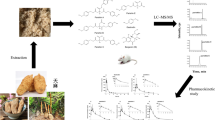Abstract
Ginsenoside Rh2 is a “hot” natural compound with great potential as a new anti-cancer drug based on abundant pharmacological experiments. However, no systemic pharmacokinetic study of Rh2 was reported because current analysis methods could not fully meet the requirements. Thus, we developed a simple LC/MS method with highly improved sensitivities for the determination of Rh2 in rat plasma, bile, urine, feces and most tissues. The tissues and feces were firstly homogenized mechanically using buffer and methanol as the media, respectively. Plasma, bile, urine and tissue homogenates were extracted with diethyl ether for sample preparation. Feces homogenates were directly deproteinized with acetonitrile. The subsequent analysis procedures were performed on a Shimadzu LCMS2010A system (electrospray ionization single quadrupole mass analyzer), with an ODS column (150 mm × 2.0-mm i.d., 5 μm) plus a C18 guard column for separation and ammonium chloride (500 μmol) as mobile phase additive. The proportions of mobile phase were changed timely according to gradient programs. Chlorinated adducts of molecular ions [M + Cl]− of Rh2 at m/z 657.35 and internal standard digitoxin at m/z 799.55 were monitored in selective ion monitoring mode of negative ions. The method was validated to be accurate, precise and rugged with good linearity in all matrices, according to the FDA guidelines. The lower limits of quantitation in rat plasma, urine and feces were 0.2, 0.2 and 20 ng/mL respectively. Stability studies were also performed, indicating that there were no stability-related problems in the analytical procedure of Rh2. The proposed method was successfully applied to the preclinical pharmacokinetic research of Rh2 in rats, including plasma kinetics, tissue distribution and excretion studies.







Similar content being viewed by others
Abbreviations
- LC/ESI/MS:
-
liquid chromatography electrospray ionization mass spectrometry
- HPLC:
-
high-performance liquid chromatography
- LLOQ:
-
lower limit of quantitation
- LC/MS/MS:
-
liquid chromatography tandem mass spectrometry
- LOD:
-
limit of detection
- IS:
-
internal standard
- QC:
-
quality control
- CDL:
-
curved desolvation line
- DC:
-
direct current
- RF:
-
radiation frequency
- SIM:
-
selective ion monitoring
- FDA:
-
Food and Drug Administration
- CV:
-
coefficient of variation
- SPE:
-
solid-phase extraction
- LLE:
-
liquid–liquid extraction
- t 0 :
-
dead time
- ME:
-
matrix effect
- MRT:
-
mean residence time
- T 1/2 :
-
elimination half life
- AUC:
-
area under the concentration–time curve
References
Kitagawa I, Yoshikawa M, Yoshihara M, Hayashi T, Taniyama T (1983) Yakugaku Zasshi 103:612–622
Attele AS, Wu JA, Yuan CS (1999) Biochem Pharmacol 58:1685–1693
Park JA, Lee KY, Oh YJ, Kim KW, Lee SK (1997) Cancer Lett 121:73–81
Kim HE, Oh JH, Lee SK, Oh YJ (1999) Life Sci 65:PL33–PL40
Ham YM, Chun KH, Choi JS, Kim DH, Lee SK (2003) Biochem Biophys Res Commun 304:358–364
Tatsuka M, Maeda M, Ota T (2001) Jpn J Cancer Res 92:1184–1189
Lee YN, Lee HY, Chung HY, Kim SI, Lee SK, Park BC, Kim KW (1996) Eur J Cancer 32A:1420–1428
Nakata H, Kikuchi Y, Tode T, Hirata J, Kita T, Ishii K, Kudoh K, Nagata I, Shinomiya N (1998) Jpn J Cancer Res 89:733–740
Fei XF, Wang BX, Tashiro S, Li TJ, Ma JS, Ikejima T (2002) Acta Pharmacol Sin 23:315–322
Cheng CC, Yang SM, Huang CY, Chen JC, Chang WM, Hsu SL (2005) Cancer Chemother Pharmacol 55:531–540
Fuzzati N (2004) J Chromatogr B 812:119–133
Xie HT, Wang GJ, Sun JG, Tucker I, Zhao XC, Xie YY, Li H, Jiang XL, Wang R, Xu MJ, Wang W (2005) J Chromatogr B 818:167–173
Cai ZW, Qian TX, Ricky NS, Wong B, Jiang ZH (2003) Anal Chim Acta 492:283–293
Sun JG, Wang GJ, Xie HT, Li H, Pan GY, Tucker I (2005) J Pharm Biomed Anal 38:126–132
Li K, Chen X, Xu J, Li X, Zhong D (2005) Rapid Commun Mass Spectrom 19:813–817
Xie HT, Wang GJ, Lv H, Wang R, Sun JG, Jiang XL, LiH, Wang W, Huang CR, Xu MJ (2005) Eur J Drug Metab Phamacokinet 30:63–67
Qian T, Cai Z, Wong RNS, Jiang ZH (2005) Rapid Commun Mass Spectrom 19:3549–3554
Lee WK, Kao ST, Liu IM, Cheng JT (2006) Clin Exp Pharmacol Physiol 33:27–32
US Department of Health and Human Services (2001) Guidance for industry, bioanalytical method validation. Food and Drug Administration, Center for Drug Evaluation and Research
Ardrey RE (2003) Liquid chromatography–mass spectrometry: an introduction. Wiley, England
Pang H, Wang HL, Fu L, Su CY (2001) Acta Pharma Sinica 36:170–174
Wang H, Zou H, Kong L, Zhang Y, Pang H, Su C, Liu G, Hui M, Fu L (1999) J Chromatogr B 731:403–405
Xu QF, Fang XL, Chen DF (2003) J Ethnopharmacol 84:187–190
Kebarle P, Tang L (1993) Anal Chem 65:972A–986A
Buhrman D, Price P, Rudewicz P (1996) J Am Soc Mass Spectrom 7:1099–1105
Fu I, Woolf EJ, Matuszewski BK (1998) J Pharm Biomed Anal 18:347–357
Matuszewski BK, Constanzer ML, Chavez-Eng CM (2003) Anal Chem 75:3019–3030
Acknowledgements
This research was supported by the National High Technology Foundation of China (“863” Projects, No.2003AA2Z347A and No.2005AA2Z3C70), the fund of Jiangsu Key Lab of Drug Metabolism and Pharmacokinetics (No.BM2001201), National Nature Science Fund (No. 30572228), and the Natural Science Foundation of Jiangsu Province (BK 2005098). The great assistance from the group of post-graduates in the Key Lab of Drug Metabolism & Pharmacokinetics, China Pharmaceutical University is highly appreciated.
Author information
Authors and Affiliations
Corresponding author
Rights and permissions
About this article
Cite this article
Gu, Y., Wang, GJ., Sun, JG. et al. Quantitative determination of ginsenoside Rh2 in rat biosamples by liquid chromatography electrospray ionization mass spectrometry. Anal Bioanal Chem 386, 2043–2053 (2006). https://doi.org/10.1007/s00216-006-0857-8
Received:
Revised:
Accepted:
Published:
Issue Date:
DOI: https://doi.org/10.1007/s00216-006-0857-8




